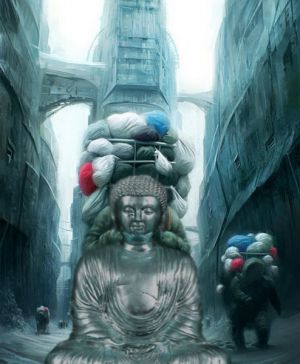Influential Silk Road Women: Empress Wu Zetian and the Spread of Buddhism (625-705 C.E.)
Buddhism was carried into East Asia by merchants and Buddhist monks traveling the Silk Road from Northern India, Persia, Kashmir and Inner Asia. One of the most powerful champions of Buddhism in China was the Empress Wu Zetian. During her Tang Dynasty reign, the practice of Chinese Buddhism is known to have reached it’s height and influence.
Empress Wu Zetian ruled as China’s only female emperor. In promoting Buddhism over Confucianism and Daoism as the favored state religion, the Empress countered strongly held Confucian beliefs against female rule. To justify her rule, Wu used selected Buddhist scriptures and led the way in the creation of numerous visual representations of the Buddha. The most spectacular are the stone temples and statues chiseled into grottoes at Longmen, near her capital. In the largest cave there is a statue called the Grand Vairocana Buddha. Carved in limestone, the colossal statue is reputed to have been carved in Wu’s own likeness. Whether true or not, it is what people believed.
Given Tang China’s rich history of inter-regional connections and communications with its East Asian neighbors, it is not surprising that Wu’s sponsorship of Buddhism resulted in a flurry of scholarly exchanges, and the construction of many new pilgrimage Buddhist sites. Creating overpowering statues, like the one at Longmen, was important. There was a sense of trying to keep up with ones rivals by building something bigger than they had. These monumental statues, like the one carved into the mountain at Bamiyan, Afghanistan, which was destroyed by the Taliban in 2001, alerted the populous to the dominance of Buddhism. They also functioned as powerful reminders of imperial power. At these pilgrimage sites, rituals were performed which established a link between the standing Buddha and the ruler. For example, at the statue’s “eye opening” ceremony which dedicated the monument, the ruler was ritualistically seen to have been given the right to rule through the divine mandate of the Buddha icon.
A Japanese example: In the late 7th century, Japan’s Emperor Shomu and Empress Komyo both were involved in Buddhist buildings. The court followed Empress Wu’s example by creating an enormous statue of the Vairocana Buddha in gold and copper at the Todaiji monastery in Nara, Japan’s capital. At a nunnery she established, Empress Komyo sponsored the creation of a statue of the Bodhisattva Kannon which, like Wu Zetian’s statue at Longmen, was felt to be done in her likeness. Kannon embodies compassion, and when seen as female is venerated as a patron of motherhood and fertility.
